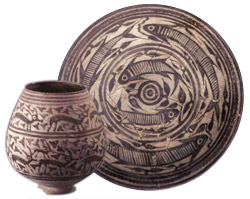 The Indus Valley Civilization, also known as Harappan culture, is among the world's earliest civilizations, contemporary to the Bronze Age civilizations of Mesopotamia and Ancient Egypt. It peaked around 2500 BCE in the western part of South Asia, declined during the mid-2nd millennium BCE and was forgotten until its rediscovery in the 1920s by R.D. Banerjee.
The Indus Valley Civilization, also known as Harappan culture, is among the world's earliest civilizations, contemporary to the Bronze Age civilizations of Mesopotamia and Ancient Egypt. It peaked around 2500 BCE in the western part of South Asia, declined during the mid-2nd millennium BCE and was forgotten until its rediscovery in the 1920s by R.D. Banerjee.Geographically, it was spread over an area of some 1,260,000 km, comprising the whole of modern day Pakistan and parts of modern-day India and Afghanistan. Thus there is an Indus Valley site on the Oxus river at Shortughai in northern Afghanistan (Kenoyer 1998:96) and the Indus Valley site Alamgirpur at the Hindon river is located only 28 km from Delhi. At its peak, the Indus Civilization may have had a population of well over five million.
The native name of the Indus civilization may be preserved in the Sumerian Me-lah-ha, which Asko Parpola, editor of the Indus script corpus, identifies with the Dravidian Met-akam "high abode/country". He further suggests that the Sanskrit word mleccha for "foreigner, barbarian, non-Aryan" may be derived from that name.
Additionally, there is some disputed evidence indicative of another large river, now long dried up, running parallel and to the east of the Indus. The dried-up river beds overlap with the Hakra channel in Pakistan, and the seasonal Ghaggar river in India. Over 500 ancient sites belonging to the Indus Valley Civilization have been discovered along the Hakra-Ghaggar river and its tributaries (S.P. Gupta 1995: 183).
 In contrast to this, only 90 to 96 of the over 800 known Indus Valley sites have been discovered on the Indus and its tributaries. A section of scholars claim that this was a major river during the third and fourth millennia BCE, and propose that it may have been the Sarasvati River of the Rig Veda. Some of those who accept this hypothesis advocate designating the Indus Valley culture the "Sarasvati-Sindhu Civilization", Sindhu being the ancient name of the Indus River. Most archeologists dispute this view, arguing that the old and dry river died out during the mesolithic age at the latest, and was reduced to a seasonal stream long before the Vedic period.
In contrast to this, only 90 to 96 of the over 800 known Indus Valley sites have been discovered on the Indus and its tributaries. A section of scholars claim that this was a major river during the third and fourth millennia BCE, and propose that it may have been the Sarasvati River of the Rig Veda. Some of those who accept this hypothesis advocate designating the Indus Valley culture the "Sarasvati-Sindhu Civilization", Sindhu being the ancient name of the Indus River. Most archeologists dispute this view, arguing that the old and dry river died out during the mesolithic age at the latest, and was reduced to a seasonal stream long before the Vedic period.By 4000 BCE, a distinctive, regional culture, called pre-Harappan, had emerged in this area. (It is called pre-Harappan because remains of this widespread culture are found in the early strata of Indus civilization cities.) Trade networks linked this culture with related regional cultures and distant sources of raw materials, including lapis lazuli and other materials for bead-making. Villagers had, by this time, domesticated numerous crops, including peas, sesame seeds, dates, and cotton, as well as a wide range of domestic animals, including the water buffalo, an animal that remains essential to intensive agricultural production throughout Asia today.